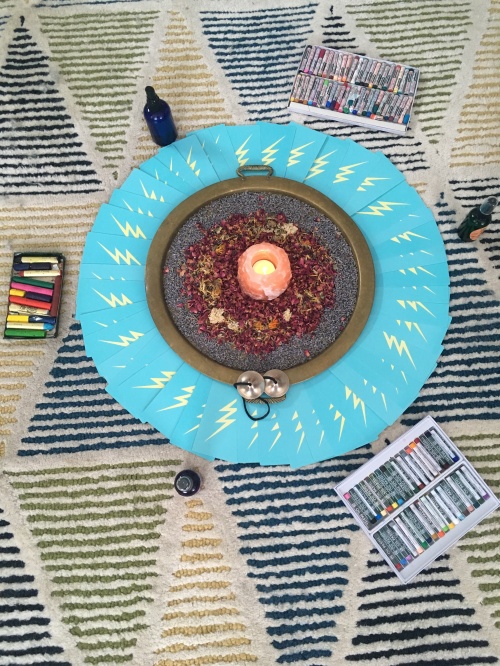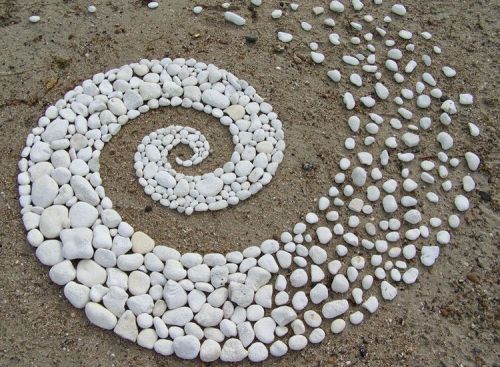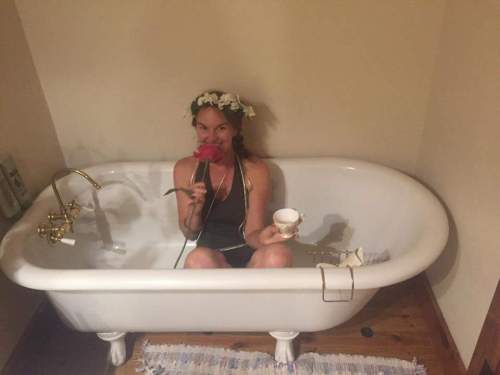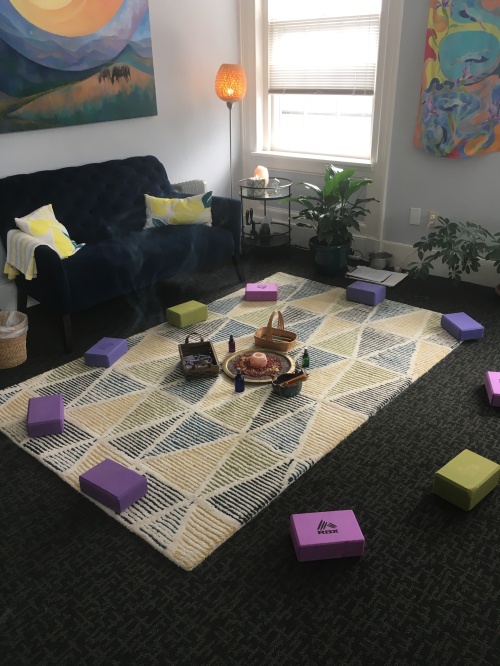 I have been wearing this bracelet since Wednesday evening. It is very simple; one bead of Czech glass, one of jasper, and one of turquoise. As I type or write or lift a cup of tea to my lips, I let my eyes rest on these simple beads and a sense of purpose fills my heart.
I have been wearing this bracelet since Wednesday evening. It is very simple; one bead of Czech glass, one of jasper, and one of turquoise. As I type or write or lift a cup of tea to my lips, I let my eyes rest on these simple beads and a sense of purpose fills my heart.
On Wednesday, we met for our second week of Permaculture and the Psyche workshops. This week we discussed the practice of stacking functions: the ecological imperative of multifunctionality. The bracelet I now wear was the result of the lengthy artistic process: first we discerned our needs through writing, yoga, and co-counseling; then refined them through guided meditation; finally we made them tangible through the selection of beads to represent each core need. Now, every time I gaze at my wrist, I am reminded of who I want to be, what I want to be doing, and how I want to experience my life.

Stacking functions, in permaculture design, is about getting multiple needs met with a single element. You may be familiar with the Three Sisters garden in which corn, beans, and squash are grown together. This garden stacks functions beautifully: the corn serves the function of both food and a pole for the beans to climb on. The beans serve the function of fixing nitrogen to replenish the nutrients that corn, a notorious heavy feeder, draws from the soil. Squash spreads between them, serving the function of shading the soil to minimize water loss through evaporation and also shading out any weeds that might compete with the corn and beans. By stacking these functions with clever interplanting, the three sisters garden does away with the need for poles, fertilizer, mulch, water, and the labor of weeding!

We can “stack functions” in our own lives by meeting several core needs with a single action. I gave this example on Wednesday:
after work each day, I have an hour or so to transition from the work environment to my home. I spend my days in a small office, away from the sun and light of the outdoors. I want to get outside and see my friends. I want to move my body and renew myself from any difficult encounters. But with all of these needs to meet, and only an hour in which to meet them, it behooves me to stack functions! I could go for a run and meet my need for sun and exercise. I could take a friend for a drink and fulfil my social need for friendship. Or, I could walk to the yoga center and ask a friend to join me in a yoga class, thus meeting my needs for motion, friendship, renewal, and sunlight in one fell swoop!
Of course, our needs change every day. It is important to remember to cultivate that internal witness (last week, we processed the permaculture principle everything gardens, using yoga, meditation, and artmaking to cultivate the inner witness. We learned how to observe the forces gardening and shaping us just as a permaculture designer observes the light, wind, and water that moves across a landscape. Read this post for more) so that we stay flexible in our responses. Some days I don’t want to be social and active at all; my body tells me to go home and sleep! But maybe I can walk home, and change my route to include the grocery store, so that I stack the functions of preparing for dinner and getting some sunlight and exercise into my journey.
Discerning the core needs of a system is the first step in any good design. We do this through observation and the careful collection of data. Every piece of land is yearning toward something; left alone; it will go through a process of natural succession and arrive at a humming homeostasis, whatever the climax community is for that particular piece of land.
There is a phenomenal amount of potential energy in that groundswell. When we fight that energy, say by plowing a piece of land and inserting rows of tomato plants, we set ourselves up to battle weeds, insects, erosion, and disease.
But if we observe, and discern what the land wants to be, we can use design as a bridge to meet all the needs of the system with plants that are useful to us. Then, that groundswell of energy will surge forward through the design instead of against it. In temperate forest like we have here in Asheville, we might plant a forest of fruit and nut trees, edible and medicinal shrubs, and edible-tuber, edible-green, or insectary ground layers wound through with wild grape to mimic the composition of the forest this land wants to be. Such a design, if well-implemented, will fare far better than the rows of tomatoes.
The difference between a tomato garden and a food forest is one of complexity and relationship. The way we design relationship and complexity into our gardens (or our psyches!) is by stacking functions: placing each element of our system into elegant relationship with other elements in order to meet our needs as efficiently as possible.
 It is important to note that stacking functions is just one part of the equation. There is another permaculture principle that reminds us to design in multiple elements for each function: the reverse of stacking functions. Imagine, in the three sisters garden, if there were to be a terrible drought. Yes, the large squash leaves shade the ground, helping to conserve water in the soil, but if there is no water there to conserve, all three plants will die. We need to have a back up system, perhaps a well-placed rain barrel to collect roofwater from the garden shed, to meet the function of watering in case our first element fails.
It is important to note that stacking functions is just one part of the equation. There is another permaculture principle that reminds us to design in multiple elements for each function: the reverse of stacking functions. Imagine, in the three sisters garden, if there were to be a terrible drought. Yes, the large squash leaves shade the ground, helping to conserve water in the soil, but if there is no water there to conserve, all three plants will die. We need to have a back up system, perhaps a well-placed rain barrel to collect roofwater from the garden shed, to meet the function of watering in case our first element fails.
Last year, my stomach muscles split open in a severe case of diastasis rectii and major surgery was required to repair the damage. I discovered very quickly that I had become reliant on physical exercise as my only stress-management tool. Lying flat on my back for the months of surgery recovery, I had to quickly re-learn the importance of designing in multiple elements to meet core needs! Now, I have learned to process stress by meditating, talking with friends over tea, and writing (although exercise is still my go-to!) This way, my entire stress-management system won’t crash the next time I experience injury.

me, managing stress
This process of observing life, discerning core needs, and designing strategies to meet them efficiently (with back ups!) can sound a bit exhausting. Applying our intelligence—even our awareness!—consciously to our lives is not something that most of us are taught. But I have found that when I take the time to observe myself and my true needs, I can design a life that works with my natural tendencies rather than fighting them. In the long run, this saves immense amounts of mental, physical, and emotional energy and pain.
If you want to play with this process in your life and make your own stacking-functions bracelet, read on!
Below, I’ve included a script for three guided meditations we worked with on Wednesday. Get a pen and paper, a handful of beads, and something to string them on. Find a quiet place, light a candle and some palo santo or sweetgrass, and read these meditations to yourself or have a friend read them to you.
1. Close your eyes and bring your awareness down into the very center of your self, breathing deeply and low in the belly. Find the beat of your heart and smile at the heart, notice if the heart smiles back. Breathing deeply, imagine the face of a person that you admire or even envy, a person whose way of being in the world fills you with a longing, an edge of wanting to become MORE…. Perhaps you’ve never met this person, only read of their physical or mental or spiritual accomplishments. Or maybe this is a friend whose way of being in the world inspires you…. Imagine the face of this person, their eyes, their posture as they carry themselves through the world…. Notice the effect they have on the world around them, what they are doing, the expression on their face… What is the essence of this person you so admire?… Really looking at this person, what is the word that describes their way of being in the world?… If you had to condense what it is that you so admire about them into one concept, what would it be? …
Breathing low in the belly, allowing this image of the person you admire to dissipate, keeping the word. Smiling at your heart, noticing if your heart smiles back. Coming back to the room, quietly write your word down and then close your eyes once again.
2. Now, eyes closed, breathing deeply, come back to that place in the center of yourself, finding the breath low in your belly, finding your stomach and smiling at it. Notice if it smiles back. Breathing into this smile, settling deep into your belly, picture the last time you read about something in the world that made you tear up. What do you see, or read, or hear about that fills you with a burning rage, or overwhelming joy, or a deep sorrow? What is it in the world that deeply moves you or what is it that you cannot stomach? Picture the last time you were talking so passionately about something that your heart was pounding and you couldn’t keep up with your own words. What were you talking about? …Let these memories surface, watch them, and find what is at the heart of them. What is the issue that burns brightest in your heart? What calls to you most strongly in the world? Find its essence in a single word.
Breathing deep into the stomach, letting these memories and images go, keeping the word. Smiling at your stomach and noticing if it smiles back. Bringing your attention briefly back to the room, quietly write this word down and then close your eyes once again.
3. Now, eyes closed, come back to that place in the center of yourself, finding the breath deep and full. Bring your attention into the silver lobes of your lungs. Smile at these temples that connect you through breath with the rest of life. Smile at them, and notice if they smile back. Breathing into this smile, settling deep into the fullness of the lungs, picture yourself in the place you feel most radiantly comfortable, alive, and happy. What is the place most sacred to you? Is this place outside, inside? What does it smell like? Is it bright or dark, cool or warm? What are the colors of this place, what do the textures feel like against your skin? What is it about this place that feeds you? What makes it sacred, what sets it apart from other places? How do you feel when you enter it? If there were a single word that could contain the feeling of this place, what would it be? Find the essence of this sacred place in a single word.
Breathing deep into your lungs, letting these images go, keeping the word you’ve found. Smiling at your lungs and noticing if they smile back. Slowly bringing your attention back to the room, quietly write this word down and, when you are ready, look up.
The meditations will leave you with a list of three words. Take your three words and really look at them. These three words make up the core of what is most important for you to be, do, and experience. These are the elements you want to stack in to your life design.
What currently meets these needs for you? Where in your life do you get to be the quality of the first word? Where in your life to you get to do work that addresses the second word? Where in your life do you experience the feeling evoked by the third word?
Select three beads whose color, shape, or symbol invokes each of your three words. These three beads will be the centerpiece of your talisman, reminding you always of the core of who you want to be, what you want to do, and how you want to experience life.
Tie them onto a string and wear them around your wrist.
As you make decisions throughout your day, look at these beads and quietly repeat the words to yourself. As you choose how to spend your time, ensure that these three vital needs are met in as many ways as possible. Pay particular attention to people, activities, and places that meet all three. As you go through the day, notice ways you can build in back-ups for these needs. With every decision you make, give first consideration to meeting these needs.

Next Wednesday, we are meeting at The Enneagram Center in Asheville to explore the permaculture principle of least effort for greatest effect through yoga and the expressive arts. If you’re in the area, join us by emailing Maeve Hendrix(maevehendrix@gmail.com); if not, stay tuned and I will write about the experience next week!

